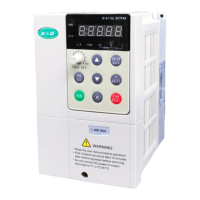ACD320 user manual Appendix
- 130-
"query/command") over the entire network. Other devices (the slave) can only provide data to
make response to the "query/command" of the master or take the corresponding actions
according to the "query/command" of the master. The master here refers to a PC,industrial
control device or programmable logic controller (PLC), and the slave refersto ACD320 inverters
or other control devices running the same communication protocol. The master can conduct
independent communications with a single slave or can advertise broadcast messages to all
slaves.For the "query/command" of the master who makes independent access, the slave should
return a message (called response); for the broadcast messages advertised by the master, the slave
does not need to make a response to the master.
5
、
Communication Frame Structure
There are two kinds of communication data format: one is RTU (Remote Terminal
Unit)mode, the other is ASCII(American Standard Code for Information International
Interchange).
In the RTU mode, format for each byte is as follows:
Coding system: Eight-bit binary notation, hexadecimal 0-9,A~F, and each 8-bit frame field
includes two hexadecimal characters.
In theASCII mode, format for each byte is as follows:
Coding system: communication protocol beongs to hexadecimal, Character meaning of
ASCII information: every hexadecimal “0”···“9”
,
“A”···“F” stand for every ASCII
information.
Character ‘0’ ‘1’ ‘2’ ‘3’ ‘4’ ‘5’ ‘6’ ‘7’
ASCII
CODE
0x30 0x31 0x32 0x33 0x34 0x35 0x36 0x37
Character ‘8’ ‘9’ ‘A’ ‘B’ ‘C’ ‘D’ ‘E’ ‘F’
ASCII
CODE
0x38 0x39 0x41 0x42 0x43 0x44 0x45 0x46
Every byte includes start bits, seven or eight data bits, parity check bits and stop bits.
The description of byte fram is as follow:
11 bit byte frame:
START Bit1 Bit2 Bit3 Bit4 Bit5 Bit6 Bit7 Bit8
No parity
check bit
Sto
p
bit
Even parity
check bit

